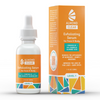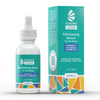Infected Hair Follicle: Treatment and Home Remedies
Infected hair follicles often occur in the beard and bikini areas. Regular application of Almond Clear is a good treatment option.
Almost everyone who has removed hair by shaving or waxing has experienced an infected hair follicle before. These bumps go hand-in-hand with hair removal, and they can be quite painful. An infected hair follicle occurs when hair that normally grows outward from the follicle begins to grow sideways beneath the surface of the skin or curls back and grows under the skin. These ingrown hairs are very prone to bacterial infection.
An infected follicle often appears as a raised, red bump. It can be warm to the touch, swollen, and itchy, and as it fills with puss and the pressure builds, it can become very painful. If the infection occurs close to the surface of the skin, then pus is usually visible right beneath the skin. Sometimes the source of the infection is deeper in the skin so the pus is not readily visible. These bumps are especially likely to occur during the warm summer months when sweat and humidity create ideal conditions for bacteria to spread on the surface of the skin.
Causes of Infected Hair Follicles
Nearly all infected hair follicles occur in areas where people shave or wax their hairs (beard area, bikini area, legs, and armpits). Shaving and waxing create finer hairs with a sharper edge, and these wispy hairs are more likely to grow sideways or poke back under the skin and get trapped.
Another cause of ingrown hairs is a buildup of dead skin cells on the outside of the skin. These skin cells can prevent hairs from popping out of the surface of the skin and force it to grow sideways or down, or dead skin cells can clog up hair follicles and cause blemishes. Treating infected hair follicles usually involves removing the buildup of dead skin cells with an exfoliating topical treatment.
People with curly hair are more likely to experience ingrowns because the hair doesn’t grow straight out of the follicle. Areas where hairs are generally more curly, such as the pubic area and beard region, are more likely to experience ingrowns.
Infected Hair Follicle Home Remedies
If your infection persists for more than a week and is very painful and swollen, then you should consider seeing a doctor. For more mild infections, the following home remedies can be effective:
- Keep the area clean and dry. You can dip a cotton swab into one of the antibacterial products listed in the last bullet point, then gently rub the swab over the red bump. Do this several times a day.
- Avoid friction in the area. If your infected follicle is under your clothing, then avoid wearing tight clothing that will rub the area because this will aggravate the infection. If the problem is in the bikini area then consider going without underwear for a few days so that the edge of your underwear doesn’t rub against the ingrown hair.
- Using a warm compress may draw the pus closer to the surface of the skin. Once the pus has come to a head, you may use a sterilized needle to puncture the skin and drain the pus. Make sure to continue to keep the area clean to avoid a secondary infection.
- Do NOT dig into the boil with tweezers to try to pull out the ingrown hair. This will only inflame the problem and possibly create a more serious infection. Once the pus has been drained from the boil and the ingrown hair is visible near the surface of the skin, you can gently remove it with sterilized tweezers.
- The most important thing that you can do to treat infected hair follicles at home is to apply an antibacterial and exfoliating product several times per day. The exfoliating properties will help to the outer layers of dead skin around the ingrown hair so that the hair can come to the surface, and will remove dead skin cells that are blocking the hair. The antibacterial properties will stop the infection and inflammation from getting worse.
- Mandelic acid is strongly exfoliating and antibacterial. It is derived from bitter almonds. Almond Clear is a product that is specially designed to treat ingrowns on the face and body.
- Salicylic and glycolic acids are also exfoliating and somewhat antibacterial, and they can be good choices for battling ingrowns.
- Tea tree oil has antibacterial properties that can calm infections. However, tea tree oil is not exfoliating.
When to see a doctor
You should see a doctor if your infected hair follicle doesn’t improve with home treatment. It's also important to talk to a doctor if you get chronic ingrown infections or clusters of ingrown hairs in the groin or armpit regions, as these boils can be symptoms of more serious health issues. Doctors can prescribe antibiotics to stop infection, remove ingrowns with a quick procedure, or recommend laser treatments for permanent hair removal.








